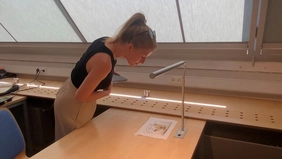Things got experimental for 4th and 6th semester students of the Bachelor's programs Digital Business, Business Administration, International Management as well as Media Psychology and Digital Business at THI Business School, who attended the seminar "Green Nudging - Contribution of Behavioral Economics to Sustainable Customer Decisions". Together with Dr. Christine Hennighausen, Professor of Media and Communication Psychology, they developed small interventions to promote sustainable consumer behavior on the THI campus via so-called “nudges”. The topics chosen were energy saving, sustainable nutrition, and waste avoidance.
One of the experiments focused on saving light in the library. For this purpose, light-saving notices were attached to single tables and the reading light was switched on. This was compared with the same amount of single tables with burning lights without a notice. At the tables with notice, all lights were turned off by the library visitors, while at the tables without notice, only half of the lights were turned off. During the test period, the signs were read and talked about by many library users. The feedback was consistently positive.
Another experiment was dedicated to cigarette waste on campus. For this purpose, posters were placed on and around the smoking islands, which drew the smokers' attention to the correct disposal of cigarettes. This resulted in three times as many cigarettes being disposed of correctly compared to smoking areas without signs.
Further interventions in the areas of energy saving and fitness (stairs instead of elevator) as well as sustainable food choices and waste avoidance in the cafeteria have not yet led to any distinct positive trends.
The didactic goal behind the experiments was to show the students the effectiveness of the Green Nudges and to establish a practical connection to the topics learned. In order to derive long-term measures from this, the interventions would have to be repeated with larger test groups over a longer period of time.


![[Translate to English:] Logo Akkreditierungsrat: Systemakkreditiert](/fileadmin/_processed_/2/8/csm_AR-Siegel_Systemakkreditierung_bc4ea3377d.webp)








![[Translate to English:] Logo IHK Ausbildungsbetrieb 2023](/fileadmin/_processed_/6/0/csm_IHK_Ausbildungsbetrieb_digital_2023_6850f47537.webp)


